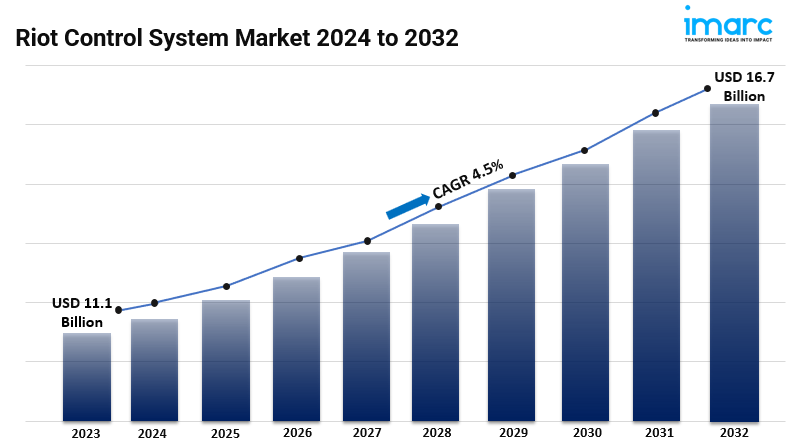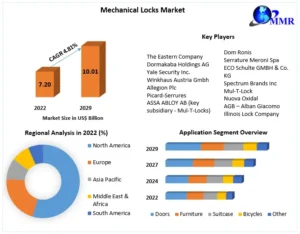
Riot Control System Industry
Summary:
- The global riot control system market size reached USD 11.1 Billion in 2023.
- The market is expected to reach USD 16.7 Billion by 2032, exhibiting a growth rate (CAGR) of 4.5% during 2024-2032.
- North America leads the market, accounting for the largest riot control system market share.
- Based on the product, the market has been segmented into defensive weapons (personal protective equipment and surveillance systems), and offensive weapons (direct contact weapons and directed energy weapons).
- On the basis of the technology, the market has been classified into electromagnetic, mechanical and kinetic, chemical and others.
- Law enforcement remains a dominant segment in the market due to the growing demand for sophisticated riot control systems to handle civil unrest and ensure public safety.
- The increase in use of non-lethal weapons is a primary driver of the riot control system market.
- The advancement in surveillance and communication technology is propelling the riot control system market.
Industry Trends and Drivers:
- Growing Adoption of Non-Lethal Weapons:
One of the most significant trends in the riot control system market is the increasing adoption of non-lethal weapons. Law enforcement agencies and security forces worldwide are placing greater emphasis on minimizing casualties while maintaining public order, leading to a growing demand for non-lethal tools such as rubber bullets, stun grenades, tear gas, and water cannons. These technologies offer a balance between controlling crowds and reducing the risk of severe injury or death, making them an attractive option for governments seeking to handle protests, riots, and civil disturbances with a focus on human rights. This trend is particularly evident in democratic nations where the use of excessive force can lead to public backlash and legal challenges. Manufacturers are responding to this demand by developing more sophisticated non-lethal weapons that are effective in incapacitating individuals or dispersing crowds while minimizing harm. The innovation in this sector is also fueled by increased funding for law enforcement modernization programs, which aim to equip security forces with advanced technologies for maintaining public safety. The development of more precise and scalable non-lethal solutions, such as directed energy weapons and acoustic devices, is expected to further drive this trend, offering law enforcement agencies more versatile tools to control crowds without escalating violence.
- Technological Advancements in Surveillance and Communication:
Another notable trend in the riot control system market is the rapid advancement of surveillance and communication technologies. As civil unrest becomes more complex and widespread, law enforcement agencies are increasingly relying on real-time data and intelligence to manage large crowds effectively. Drones, body cameras, and advanced video surveillance systems equipped with artificial intelligence (AI) and facial recognition technology are being used to monitor and identify potential threats in real-time. These systems allow security forces to track movements, detect weapons, and assess crowd dynamics, enhancing situational awareness and enabling more informed decision-making during crises. Moreover, advancements in communication technologies, such as encrypted radio systems and mobile command centers, are facilitating better coordination among law enforcement units during riot control operations. These tools enable seamless communication between ground units, command centers, and other agencies, allowing for quicker response times and more efficient deployment of resources. This trend is driven by the increasing complexity of public demonstrations, where participants may use digital tools and social media to coordinate activities. In response, law enforcement agencies are investing in technologies that enhance their ability to monitor and respond to unrest and protect their communication networks from cyber threats. As a result, technological advancements in surveillance and communication are playing a critical role in modernizing riot control strategies.
- Increasing Demand for Personal Protective Equipment (PPE):
The rising focus on officer safety during riot control operations is driving the demand for personal protective equipment (PPE). With protests and riots sometimes escalating into violent confrontations, law enforcement agencies are prioritizing the procurement of advanced PPE to protect officers from projectiles, hazardous chemicals, and physical assaults. Riot shields, helmets, body armor, gas masks, and flame-resistant suits are increasingly being adopted to ensure the safety of personnel on the front lines. The growing intensity and frequency of civil disturbances, particularly in urban areas, have highlighted the need for high-quality protective gear that can withstand various threats. In addition, the global pandemic has underscored the importance of biological protection, leading to an increased focus on PPE that offers protection against chemical, biological, radiological, and nuclear (CBRN) threats. Manufacturers are innovating in this space by developing lighter, more durable, and ergonomically designed equipment that provides better mobility and comfort for officers during prolonged operations. The integration of smart technologies into PPE, such as helmets with built-in communication systems and body armor with health monitoring sensors, is also becoming more prevalent, allowing officers to stay connected and protected while performing their duties. This trend reflects the growing recognition of the need to equip law enforcement personnel with the best protective gear to ensure their safety during high-risk situations.
Request Sample For PDF Report:https://www.imarcgroup.com/riot-control-system-market/requestsample
Riot Control System Market Report Segmentation:
Breakup By Product:
- Defensive Weapons
- Personal Protective Equipment
- Surveillance Systems
- Offensive Weapons
- Direct Contact Weapons
- Directed Energy Weapons
Based on the product, the market has been segmented into defensive weapons (personal protective equipment and surveillance systems), and offensive weapons (direct contact weapons and directed energy weapons).

Breakup By Technology:
- Electromagnetic
- Mechanical and Kinetic
- Chemical
- Others
On the basis of technology, the market has been classified into electromagnetic, mechanical and kinetic, chemical and others.
Breakup By End User:
- Law Enforcement
- Military
Law enforcement represents the majority of shares due to the increasing need for advanced riot control systems to manage civil unrest and maintain public order.
Market Breakup by Region:
- North America (United States, Canada)
- Asia Pacific (China, Japan, India, South Korea, Australia, Indonesia, Others)
- Europe (Germany, France, United Kingdom, Italy, Spain, Russia, Others)
- Latin America (Brazil, Mexico, Others)
- Middle East and Africa
Top Riot Control System Market Leaders:
- Amtec Less Lethal Systems Inc. (PACEM Defense LLC)
- Armament Systems and Procedures Inc.
- Axon Enterprise Inc.
- B&T AG, BAE Systems Plc
- Combined Systems Inc.
- Eagle Industries Inc.
- Lamperd Less Lethal Inc.
- NonLethal Technologies Inc.
- Raytheon Technologies Corporation
- Safariland LLC (Maui Acquisition Corp.).

Note: If you need specific information that is not currently within the scope of the report, we will provide it to you as a part of the customization.
About Us:
IMARC Group is a global management consulting firm that helps the world’s most ambitious changemakers to create a lasting impact. The company provide a comprehensive suite of market entry and expansion services. IMARC offerings include thorough market assessment, feasibility studies, company incorporation assistance, factory setup support, regulatory approvals and licensing navigation, branding, marketing and sales strategies, competitive landscape and benchmarking analyses, pricing and cost research, and procurement research.



